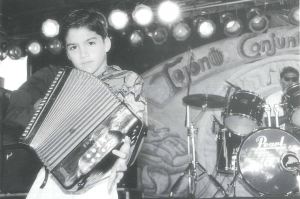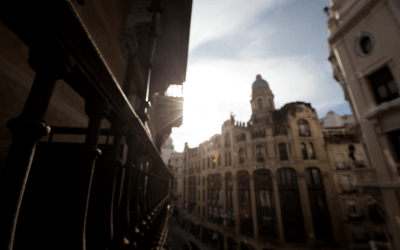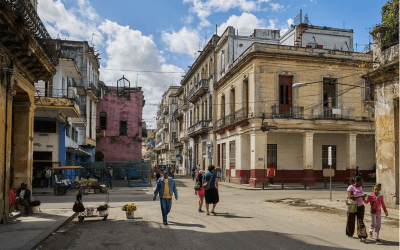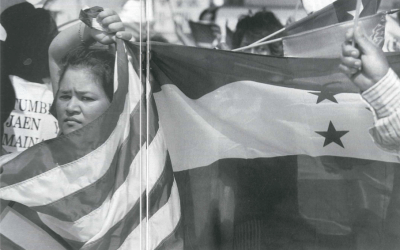The Soulfulness of Black and Brown Folk

Photo by Al Rendon. Conjunto Kid.
And so, by faithful chance, the negro folksong–the rhythmic cry of the slave–stands to-day not simply as the sole American music, but as the most beautiful expression of human experience born this side the seas. It has been neglected, it has been, and is, half despised, and above all it has been persistently mistaken and misunderstood; but notwithstanding, it still remains as the singular spiritual heritage of the nation and the greatest gift of the Negro people.
– W.E.B. DuBois, “The Sorrow Songs,” The Souls of Black Folk
Corridos first became widely used along the South Texas/ Mexican border during the early conflict between Chicanos and Anglos. The corridos are usually about Mexican heroes who do valiant deeds against the Anglo oppressors. . . . The everpresent corridos narrated one hundred years of border history, bringing news of events as well as entertaining. These folk musicians and folk songs are our chief cultural myth-makers, and they made our hard lives seem bearable.
– Gloria Anzaldúa, Borderlands/ La Frontera: The New Mestiza
As a Mexican-American from the Southwest, I will never forget my first encounter with George Clinton’s unabashed and unapologetic “Chocolate City,” a politically-minded milestone in the world of funk music. Well into my second semester at an elite, Ivy League university, I still felt like an outsider. The intricate and ornate architecture left me feeling cold; the foliage was lush and green, but the sky seemed small and sad. And although my immediate friendships were deep and growing, as I walked through a campus of thousands, I missed the presence of anonymous brown faces, such as were found in my Texas bordertown.
In my more escapist moments, I turned to music. It was George Clinton’s Parliament/ Funkadelic that took me farthest away from my lily-white Ivory Tower. “There’s a lot of chocolate cities around,” I would here Clinton say. “We’ve got Newark, we’ve got Gary. Somebody told me we got L.A….But you’re the capital, C.C.” A sly euphemism for Washington, D.C., the “Chocolate City”– C.C. — represented the site, both figurative and geographic, of Clinton’s alternative political and social order. I made many mental pilgrimages there, the place where “Ali is in the White House…Richard Pryor, Minister of Education; Stevie Wonder, Secretary of FINE arts; and Miss Aretha Franklin, the First Lady.” “A chocolate city is no dream,” Clinton would tell me. “It’s my piece of the rock and I dig you, C.C. God bless Chocolate City and its vanilla suburbs.”
As those familiar with the song know, Clinton lays special emphasis on the words “vaannnilla suuuuburbs” in a way that hoots, “These poor white folk! They just don’t see what’s coming!” Sure enough, this underlying subtext is soon confirmed by a boisterous refrain. As if suddenly springing upon the unsuspecting listener, a multi-voiced chorus indignantly clamors “Gainin’ on ya!,” which is then contrasted by Clinton’s matter-of-fact and ever-so-cool “Get down.” The exchange continues:
Chorus: Gainin’ on ya!
Clinton: Movin’ in and on ya
Chorus: Gainin’ on ya!
Clinton: Can’t you feel my breath, heh
Chorus: Gainin’ on ya!
Clinton: All up around your neck, heh heh
This image of blacks “gainin’ on” the white establishment filled me with contradictory feelings. On the one hand, it gave me strength, for I saw myself as part of the larger everyday struggle against the legacy of white supremacy. With very few places to turn, I was ready to jump aboard Clinton’s funked-up ‘Mother Ship’ and ride to the Chocolate City. On the other hand, there was a certain predatory quality to the chorus’ “Gainin’ on ya!” as it moved “in and on ya” and as it breathed “all up around” the establishment’s neck. How would a white person react to this?, I thought. And was there a place for me, a Brown brother, in Clinton’s Chocolate City? Was there a hint of canela in Clinton’s chocolate recipe?
At about this same time that I was finding solace in Clinton’s music, I was also discovering that I was not simply a Mexican-American or Chicano, but, more broadly, a “Latin@” (among my peers) or “Hispanic” (in the eyes of the university administration). I was learning the demographic mantra: “we Latin@s will soon become the largest minority group in the United States, surpassing African Americans.” This is a prediction that Latin@s today often wear like a proud badge. Yet, this so-called objective statement of demographic fact carries with it the same ambiguities that I found in Clinton’s “Chocolate City.” I find troubling the image of Latin@s “surpassing” and “outnumbering” Blacks. I worry about the implicit assumptions that this statement may carry. Often, I hear overtones of a cultural take-over, or the assumption that it is now “our turn” in the cultural limelight, or the belief that Latin@s will simply overwhelm the nation, Blacks included, with their numbers. But is progress to be had at the expense of the surprised and overwhelmed other?
Two years ago, here at Harvard, Davíd Carrasco, a Princeton professor, and Harvard’s own Cornel West held a grounding-breaking dialogue entitled: “Whose Eyes on What Prize?: A Black-Brown Discussion on Shades of Invisibility.” Carrasco posed the question well: How can Blacks and Latin@s turn demographics into democracy? Carrasco’s appeal was, and still is, timely. In the last five years alone, riots broke out in Washington, D.C. when a black police officer shot a Latino man; Blacks and Latin@s clashed over day labor in Los Angeles, Chicago, and Denver; and Dallas’ largest schoolboard nearly splintered over Black-Brown racial tensions. As a group, Latin@s sense that their condition is improving, while Blacks often feel threatened by this “sleeping giant.” Without a doubt, the stakes are high.
In his talk, Carrasco turned to the spirit of music as a way to demonstrate the possibilities of coalition-building between Blacks and Latin@s. He played a bilingual version of “We Shall Overcome” called “Nosotros Venceremos.” After a traditional close-harmony, a-cappella gospel-style entrance, the song bursted into a lively soca beat, complete with bilingual lyrics. Ingeniously, this rendition–by Dr. Loco and the Rockin’ Jalapeño Band–paid homage to gospel, the song’s original musical form; it retained the song’s lyrics, broadening its scope through its bilingualism; and, perhaps most importantly, it reaffirmed the cathartic and emotional message of the song: as dispossessed peoples, we shall overcome our oppression!
Some readers may be wondering what this has to do with the concrete realities of Black people, Latin@s, Black-Latin@s, and the way that these folks get along with one another. Certainly, our interracial tensions will not be solved by listening to soca-fied renditions of “We Shall Overcome.” But such cultural expressions do help us understand the depth of “the common struggle of the oppressed,” whether they be Black, Brown, Yellow, White, female, gay, poor, or a combination of these. Music and a host other cultural forms open up new ways of imagining, acting in, and adapting to the world. They highlight what I will call the “soulfulness” of our struggle.
In order to get at this idea of soulfulness, it is momentarily worth thinking about the relationship between the content and form of our history. This relationship may be grasped on at least two levels. On the first level, the content of our history may be understood as the “raw data” of the past and present while the form of our history implies the way in which we interpret such data. The two are intimately interrelated. We know “things” (content) because of and through our interpretative frameworks (form). Form puts content in context, and thus, gives content its meaning. Historians have long known that it is impossible to write a purely objective account of the past, and today we generally acknowledge that our own subjective thoughts and way of framing the facts effect how the story is told.
Seen in this light, our storytelling is always a risky business. If our interpretations are, by nature, rooted in subjectivity, our knowledge is inescapably and inherently fallible and our experience always limited. For many, this is a scary proposition, for it seems to open the floodgates of relativism. Many will ask, Without a concrete and “true” place upon which to stand, how do we know what is right and wrong, good and bad, worth remembering and fighting for? The question is a fair and important one, for not only does it beg the question, What grounds as human beings?, but also, it takes seriously the need to be able to assign value to our world.
It is precisely at this point that we must appeal to a second level of the content-form relationship–the interaction between history-as-content and response-as-form. In this model, history refers to the realities of the world that happen regardless of our interpretation, and response connotes not only our subjective interpretation of these realities, but, more profoundly, our existential engagement with them. Though it should be clear that no purely objective account of history can be given, it is also equally clear that history-as-reality still happens. It happened to the six million Jews who died in the Holocaust, it happened to my neighbor’s dog yesterday, and it happens to you, the reader, as you anticipate what I will say. . . next.
Part of our job as human beings is to assign meaning and significance to the multiplicitous events of reality. Marginalized communities enact this process valiantly and repeatedly. For Blacks and Latin@s, history happened to the 11 million slaves who crossed the Atlantic between 1520 and 1860; history happened to the more than 20 million indigenous peoples who died of slavery and disease, brought to this continent by the Spanish conquistadores; and history continues to happen to the one-in-three Latin@ and Black children who go to bed hungry at night. Such accounts of reality are deemed important by virtue of the fact that we dare to proffer and construct a narrative interpretation of the “raw facts.” In so many words, we “will” that our story be told. Too much suffering and pain, hope and gain–both past and present–are at stake not to do so.
When we will and construct our narrative histories we are, in the process, performing an act of resistance. By giving ourselves voice and asserting our agency in the world, we are resisting the dominant ways in which history has been or has not been told. Today, for example, we recognize that Columbus did not so much “discover” the “New World” as he happened to come upon an already inhabited and thriving part of the globe. Such a re-interpretation serves as an important reminder that, if we look close enough, the dominant story of “progress” almost always entails an underside. By willing forth and re-constructing these narratives, we re-insert our communities onto the face of history.
At the same time, in recognizing our narrative histories as willed and constructed, we are more apt to avoid our own dogmatism about the presumed veracity of our re-constructed past. History, whether told from the perspective of the oppressor or the oppressed, is never static. It is constantly open to and in need of re-interpretation. It continually forces us to question how we tell the story and whom we leave out. We learn to take seriously the fact, for example, that the voices of women and gays have seldom been heard in Black and Latin@ histories, though they have always been a part of our communities’ reality. When we accept that our willed and constructed histories are never static notions of the past, self-critique and self-correction become integral attributes of our struggle.
All of these multiple shades of resistance point to what I would refer to as an underlying soulfulness within our two communities. Soulfulness is not a single cause or essence, nor is it an inherent marker of “our culture.” Rather, it is a form of resistance, gleaned from a sense of agency, style, and, at its best, self-critique and humility. Soulfulness is a form of reaction against oppression, and it gives the historical “facts” their edge.
The song “Chocolate City,” for example, is not only an attempt to recount some of the “facts” of Black history, both past (“We didn’t get our forty acres and a mule/ But we did get you, C.C.”) and present (“Gainin’ on ya!”) but also an effort to carve out a space for Black people in a predominantly white world. “You’re my piece of the rock/ And I love you, C.C.,” intones Clinton. Chocolate City represents not so much the fact of geographical location as it represents all the sounds, sights, smells, and ways of being-in-the-world that come with it. Clinton is in love with C.C. not so much as place, but rather, with C.C. as an embodiment of resistant soulfulness.
Much of our Black-Brown dialogue to date has neglected the powerful role of soulfulness in our common struggles for justice, instead honing in on the “facts” of history. We acknowledge that both Blacks and Latin@s share histories of racial and economic oppression, but we rarely inquire into the quality and depth of our cultural resistance. What gives us the wherewithal in the first place to even care about the facts? And what has sustained us in the past, enabling us to even confront oppression? Sadly, such questions are rarely asked in policy, business, and legal circles. Such compartmentalization misses the depth of our historical struggle. If struggle were a piece of music, it seems we have done well to take account of the formal characteristics of the song–its notes, words, instruments, players, and venue, for example–but have fallen short of appreciating the song as imaginative construction, group performance, and creative improvisation. We stop short, in other words, of taking account of the soulful form of our resistance.
“Tangible” political goals, such as better schools, fairer laws, and civic representation are certainly the ‘goods’ to be gained through our struggle. Without them, our efforts are directionless. But to assume that the progress of the race rests solely on the attainment of these goals is both historically short-sighted as well as bereft of a larger sense of what “progress” is. In the face of great odds, our communities oftentimes had very little to fall back upon except their own imaginations and personal expressions, be they in the form of music, dance, poetry, dress, cuisine, language, humor, or other everyday forms of art. It was precisely construction, performance, and improvisation that sustained our forebears. In large part, these imaginative endeavors provided them with a sense of being self. As John Coltrane once said, “When I know a man’s sound, well, to me that’s him!” Similarly, the sound–or soulfulness–of our culture determines who we, at the depths of our existence, are. Furthermore, construction, performance, and improvisation are not only historically essential, but also, they give us a sense of what we should be progressing towards. They point to that which is not yet but could be. If nothing else, they underscore the fact that public policy, business, and law is done for a purpose, and that, by and large, it is up to us to determine what that this purpose is.
As I mentioned before, soulfulness is not an innate characteristic of our cultures. It is not a ready-made resource that our communities can immediately pick-up and appropriate. Rather, it reflects the quality of our actions as we dare to recover the ugly past and as we will forth a better future. It must be continually fought for and enacted. Soulfulness reflects the depth of our responsibility to all oppressed others, and it forces us continually to ask, When we resist, what are we resisting to? Does justice mean more Latin@ visibility at the expense of other groups, or does it entail calling into question why marginalized groups must compete for such limited resources in the first place? At its core, soulfulness begs the larger question: How broad is our justice?
Chris Tirres is a doctoral candidate in Religion at Harvard University. He is the former Art Coordinator for the DRCLAS Latin American and Latino Art Forum and is an active member of Concilio Latino, the umbrella organization for all Latin@ groups at Harvard.
Related Articles
Forum on U.S. Hispanics in Madrid
The Trans-Atlantic Project, an academic initiative to study the cultural interactions between Europe, the U.S. and Latin America has been invited by Casa de América, Madrid, to present a …
Cuba Study Tour
Waiting at José Marti International Airport for the first Harvard students to arrive for January’s DRCLAS Cuba Study Tour, my companion, a theater critic at Casa de las Américas, commented to me …
The ‘Return’ of the State
The oath which immigrants are required to swear today on becoming naturalized citizens of the United States, reads, in rather archaic and high-sounding formal language: “I absolutely and …




